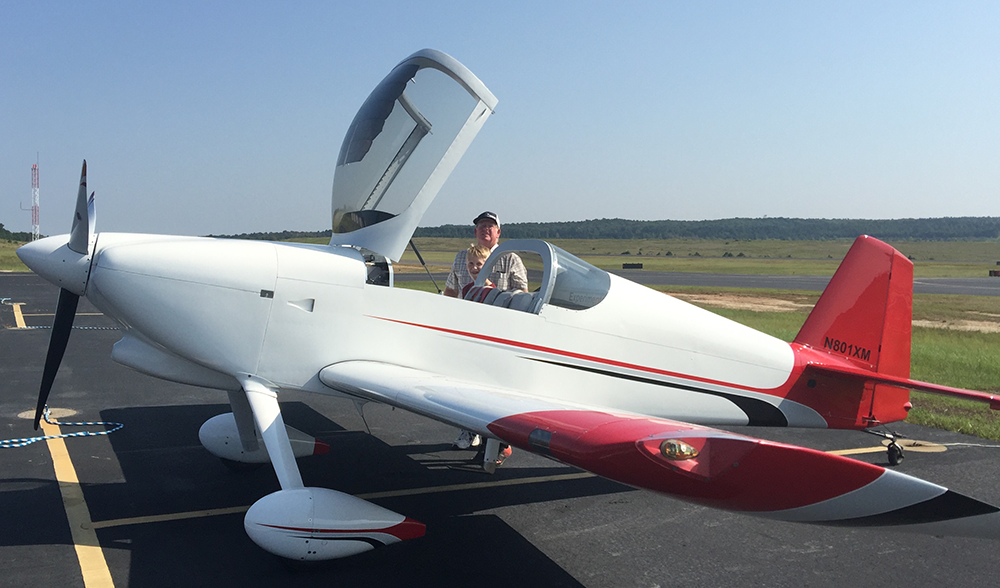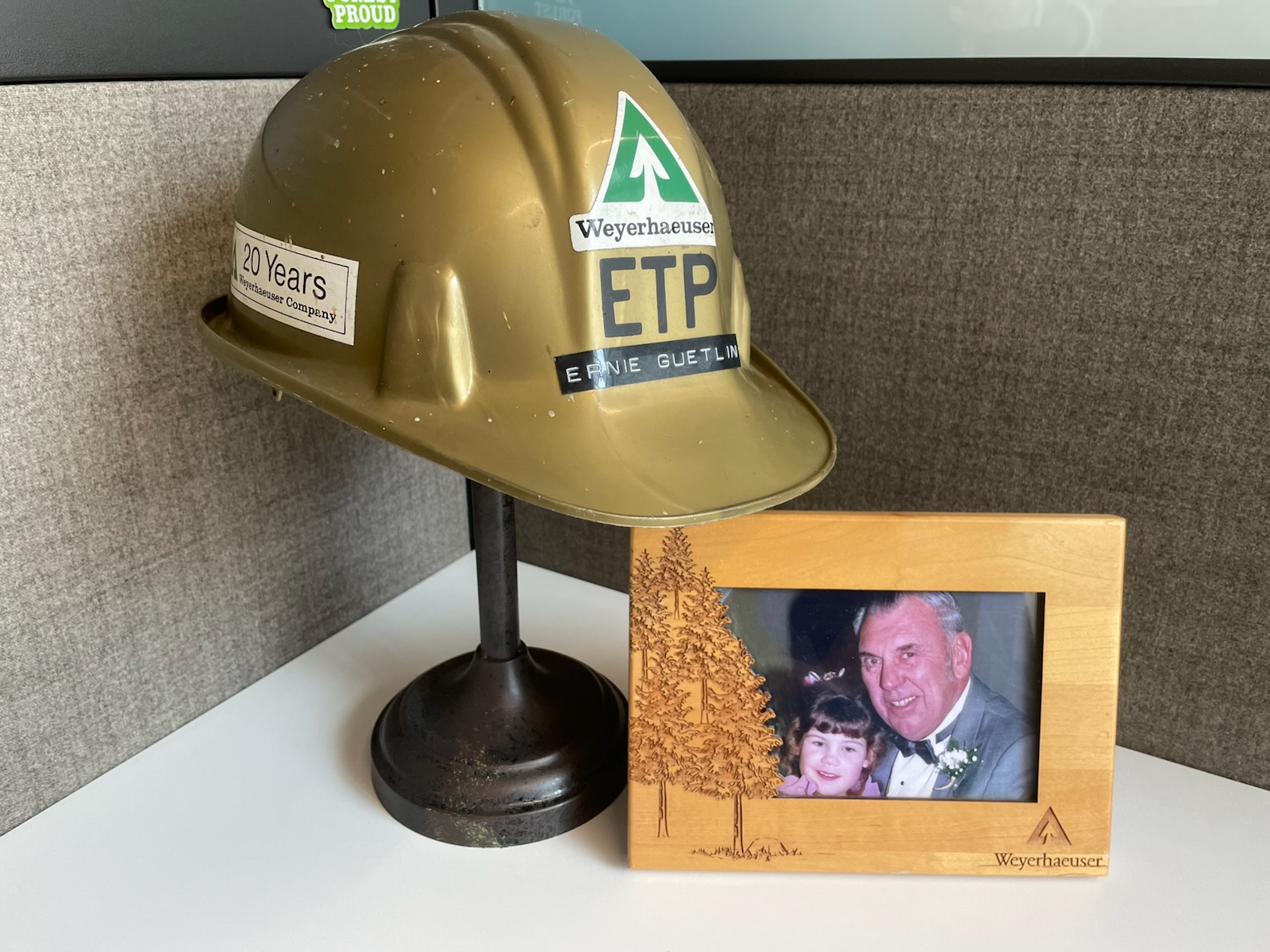'My first fire was caused by a downed power pole,' Dylan says. 'It was pitch black outside, and I was on a saw team, cutting direct hand lines to remove fuel from the fire. We ran into a bee’s nest, and I could feel them crawling up my leg while I worked. The whole experience was both terrifying and incredibly exciting, and I was hooked.' In this photo, a helicopter tanker drops water on a spot fire.
Wildland firefighting is a hard, dirty job. It often involves grueling 18-hour days on the smoky front lines of an active fire, followed by restless sleep in a tent — if sleep is even possible. But for many firefighters, including some of our own employees and contractors, the most challenging part of the work isn’t fighting the fires. It’s the end of wildfire season.
“That’s when it all truly hits you — the trauma of what you witnessed, the toll the work took on your body, and the prospect of losing your pay and benefits for the season,” says Dylan Johnson, a forester in Springfield, Oregon, who fought fires for the U.S. Forest Service to help pay for college in the mid-2010s. “Some firefighters experience depression or PTSD when the fire season ends.”
Nobody should have to go through that alone. Our Fighting Fires Together campaign, developed in partnership with Firefighter Behavioral Health Alliance (FBHA), aims to address the mental health challenges wildland firefighters experience by providing specialized support and resources. We launched the second year of the campaign on May 8 to commemorate Mental Health Awareness Month and Wildfire Awareness Month.
“As wildfires increase, we need this kind of help more than ever,” says Jason Moon, a region harvest manager in Southern Oregon who’s also a former wildland firefighter. “This campaign gives us concrete ways to take action — and hopefully provide resources that could really help firefighters in acute mental distress.”
Dylan and Jason share their own experiences with wildland firefighting and the mental health challenges firefighters may face during and after wildfire season.
Dylan hikes to a remote fire with his crew. 'Once, in Montana in 2017, we had to go door to door to tell people to evacuate,' he says. 'We tried to save their houses, but some had yards full of flammable stuff, so we had to just put up sprinklers and say, ‘Best of luck.’ Some people got really angry with us, which was hard on our morale.'
DYLAN: THE IMPORTANCE OF FIREFIGHTERS HELPING EACH OTHER
When Dylan heard he could make good money as a seasonal wildland firefighter between semesters in community college, he jumped at the opportunity. He earned his firefighting certifications during a summer internship in 2015.
Dylan spent the next four fire seasons (which typically run mid-May through late September/early October in the Northwest) fighting wildfires throughout Oregon and Montana. His crew often chased lightning storms through the Cascade Mountains, the Umpqua National Forest and the Willamette River Valley. He’d sometimes work for 36 hours straight during his two-week deployments, with no access to showers or hot meals.
In 2018, Dylan’s beloved crew boss passed away.
“It was hard on everyone,” he says. “My unit lost the sense of camaraderie we once had.”
Dylan and his fellow firefighters could tell one member of their crew was especially struggling, but they felt helpless to intervene.
“This guy needed a specific medications, but they were really expensive, and he was paying out of pocket,” Dylan says. “He had a lot of student debt, too. Because firefighters are classified as temporary seasonal workers, when we weren’t actively fighting fires we made just $12 to $14 an hour, and we had no health insurance. If we’d all talked about these challenges more or knew how to access resources, maybe we could have done more to help him.”
'Reaction from the community is mixed,' Dylan says. 'Most of the time, rural people in particular appreciate our hard work because they understand the impact of a large fire, but sometimes people blame firefighters for lack of fire management or for policies enacted by the federal government. They’ll come up to us and say things like, "You’re the reason I lost my hunting grounds last year." I wish more people understood we’re doing absolutely everything we can.'
JASON: WORKING THROUGH THE TOUGHEST TIMES
In the early 2000s Jason spent eight years fighting fires for the Washington State Department of Natural Resources, working as a ‘dozer boss’ and managing the deployment of heavy equipment to every fire in the area.
“The initial attack could be a little chaotic,” he says. “We were among the first responders, trying to manage resources and teams coming in while maintaining awareness of the fire activity and how to respond safely. In those moments, there were lots of lives in our hands, and people’s livelihoods were at stake. Trying to make the right calls could feel overwhelming.”
Firefighters don’t always have time to think about the full picture of a situation, as they are often putting all their energy into emergency response. The emotional impact of decisions made sets in afterward, especially if there were injuries or fatalities.
“If you don’t work through those feelings, you can end up with some skeletons in your closet,” Jason says. “It could be days, months or even years before it hits you. I think we’ve lost more firefighters to suicide than we have to fires, and that’s incredibly tragic.”
Dylan and his crew hike to another fire. 'I learned leadership skills and communication skills that I still use today,' Dylan says. 'Firefighting is sort of like being in the military, with a lot of discipline and training opportunities. It’s challenging, but the rewards are incredible. I encourage anyone who’s interested to give it a try. The most important thing is to be aware that you might experience some tough emotions and be ready to access help if you need it.'
A PATHWAY TO SUPPORT
Our Fighting Fires Together website offers new videos created by FBHA on the topics of Post Traumatic Stress Disorder (PTSD), depression, anxiety and suicide prevention, mental health tips and resources such as tools to self-screen for suicide risk and contacts for occupationally aware counselors located in Oregon, Washington and British Columbia. You’ll also find wildfire facts and figures, contact information for community support groups, and tips for family and friends of wildland firefighters. And though some resources are tailored for the Pacific Northwest, where wildfires are a more common challenge, most of the materials are applicable to anyone involved in wildland firefighting.
If you’re wondering how you can personally help, Jason and Dylan recommend keeping outdoor fire safety in mind at all times. Nearly 85 percent of wildfires are caused by human activity, so you should always take care to properly manage any fires, including campfires, and avoid sparking flames around dry vegetation.
“You can protect your own home from wildfires by creating defensible space, which includes clearing flammable materials and preventing ember penetration into vents,” Jason says. “Even more importantly, have a plan to evacuate before a fire starts anywhere near you, and know when to evacuate. Homes are replaceable. People aren’t.”
Jason and Dylan agree that post-fire support for firefighters is starting to change for the better, but wildland firefighters still need more public support.
“You can help us by advocating for better fire management in wildfire-prone areas and advocating for improved conditions for firefighters, like benefits and off-season work opportunities,” Dylan says. “As wildfires increase, we need firefighting to be a sustainable, secure and well-paying career.”


